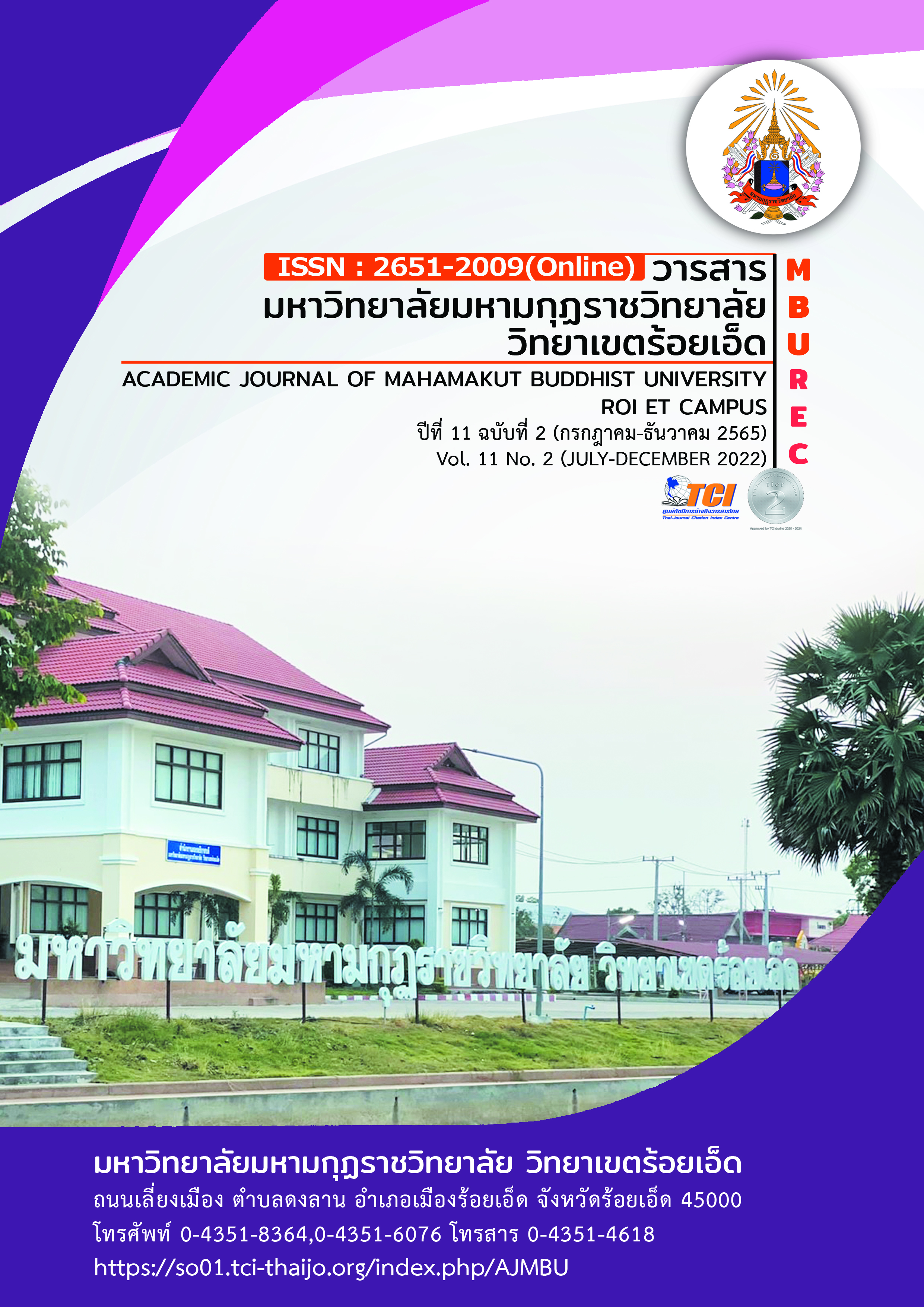CULTURAL IDENTITY OF FORN HANG NOK-YOONG IN FORN BHU CHA PHRA THARD PHANOM
Main Article Content
Abstract
“Forn Hang Nok-Yoong” is a worship dance performed at Phra That Phanom temple in Nakhon Phanom province, usually to show reverence to Buddhists who have devotion to Phra That Phanom. This research aims to study cultural identity and the history of the “Forn Hang Nok-Yoong” in the Buddhist Lent tradition at Wat Phra That Phanom, That Phanom District, Nakhon Phanom province. By studying paper work and collecting data in the field through surveys, observations and interviews. The tools used for data collection were observation form and interview form, from 3 experts, 20 practitioners, 20 audience members, 43 people in total. The results of the data analysis were presented by descriptive analysis method.
The results revealed that Forn Hang Nok-Yoong was used in the worship Phra That Phanom in the tradition of the end of Buddhist Lent. It shows the identity that appears in the form of performance has its own distinctive identity, the culture of beliefs that have been cultivated from past to present. It has developed some forms, but still retains the unique identity of the performance.In addition, “Forn Hang Nok-Yoong” has been modified according to the era and to the social context of every period. The dance also provides the belief of warding off the bad spirit from the people’s lives and bring prosperity to lives which is one of the beliefs in Southeast Asia.Therefore, the “Forn Hang Nok-Yoong” is present in the society of the Isan people and has become a heritage preserved for the wisdom that has been passed down to the people of Nakhon Phanom to maintain it.
Article Details

This work is licensed under a Creative Commons Attribution-NonCommercial-NoDerivatives 4.0 International License.
References
การท่องเที่ยวแห่งประเทศไทย. (2542). คู่มือท่องเที่ยวนครพนม. กรุงเทพมหานคร : ม.ป.พ..
แก้ว อุทุมมาลา. (2537). อุรังคนิทาน ตำนานธาตุพนม. กรุงเทพมหานคร : นีลนารากการพิมพ์.
จันทร รัศมี ผู้ให้สัมภาษณ์. 21 ตุลาคม 2562. ณ โรงเรียนนครพนมวิทยาคม อำเภอเมือง จังหวัดนครพนม.
ธีรารัตน์ ลีลาเลิศสุระกุล. (2559). ทางอีศาน. ความเชื่อ...สู่พลังศรัทธา สายธารของวัฒนธรรมประเพณีอีสาน. นนทบุรี : สำนักพิมพ์ทางอีศาน.
เพจประวัติศาสตร์อีสานล้านช้าง. (2564). ฟ้อนหางนกยูง. สืบค้นเมื่อ 20 ตุลาคม 2563. จากhttps://www.facebook.com/103752477993915/post/138029924566170/
มีเดช เตโช. (2554). ประเพณีรำบูชาพระธาตุพนม. กรุงเทพมหานคร : สยามรัฐ.
วัฒนศักดิ์ พัฒนภูทอง ผู้ให้สัมภาษณ์. 17 เมษายน 2562. ณ โรงเรียนเชียงยืนวิทยา อำเภอศรีสงคราม จังหวัดนครพนม.
ศิขรา ศิริสาร. (2556). กระบวนการสร้างปฏิสัมพันธ์และการสร้างอัตลักษณ์ร่วมในแฟนเพจเฟซบุ๊ก :ศึกษากรณีแฟนเพจอิปคิงดอม. วารสารวิทยบริการ. 24(3). 1-17.
ศุภวัฒน์ นามปัญญา. (2562). ฟ้อนผู้ไทย : การนำเสนอภาพตัวแทนทางชาติพันธุ์ผู้ไทย ในขบวนแห่ปราสาทผึ้งจังหวัดสกลนคร. วิทยานิพนธ์ศิลปศาสตรมหาบัณฑิต สาขาการวิจัยและสร้างสรรค์ศิลปกรรมศาสตร์. มหาวิทยาลัยมหาสารคาม.
สุรพล วิรุฬห์รักษ์. (2547). หลักการแสดงนาฏยศิลป์ปริทรรศน์. กรุงเทพมหานคร : จุฬาลงกรณ์มหาวิทยาลัย.
อคิน รพีพัฒน์. (2551). วัฒนธรรมคือความหมาย. กรุงเทพมหานคร : ศูนย์มานุษยวิทยาสิริธร.
อภิญญา เฟื่องฟูสกุล. (2546). อัตลักษณ์ : การทบทวนทฤษฎีและกรอบแนวคิด = Identity.กรุงเทพมหานคร : คณะกรรมการสภาวิจัยแห่งชาติ สาขาสังคมวิทยา สำนักคณะกรรมการวิจัยแห่งชาติ.
อภิศักดิ์ โสมอินทร์. (2537). โลกทัศน์อีสาน. มหาสารคาม : อภิชาติการพิมพ์.


